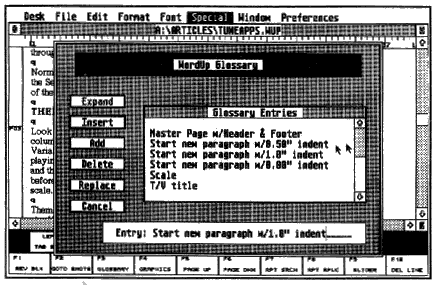WORDUP
VERSION 2.0
Beyond MacWrite for the ST
BY JIM PIERSON-PERRY, START CONTRIBUTING EDITOR
While the perfect word processor remains a Holy Grail, Neocept has taken another step toward it for ST/Mega users with its release of WordUp version 2.0. Commercially available for two years, WordUp was the first word processor for the ST to marry text and graphics in a true WYSIWYG (what you see is what you get) environment. This type of program is often referred to as a document processor.
New features in this upgrade include support for hanging indent tabs (outdents), accent mode to create composite characters, the ability to import GEM metafiles and DEGAS Elite compressed picture files and provide scaled font point sizes derived from the native GDOS fonts. Lingering bugs from earlier versions, such as the 32K limit on importing IMG files and crashing if out of free memory, have been eradicated and the program's overall speed has been significantly boosted. 520ST users will appreciate the additional 40K of memory that has been freed up and the ability to use a 24-pin printer.

Sample printout from
WordUp using an SLM804 laser printer. This
shows off some of the
program's graphic-import capabilities, as well
as multiple fonts and
styles on the same page.
Setting Up
Installation went smoothly on my hard drive. WordUp comes as a set
of nonstandard archived files on three program disks. A well-designed installation
program automatically extracts the files and sets up a GDOS font/driver
folder and ASSIGN.SYS file for you.
At this writing, GDOS printer drivers are provided for the Epson FX/MX/JX/LQ series, Atari SMM804, Citizen Tribute 224, Toshiba P series, Atari SLM804 laser printer and HP Laserjet/DeskJet (through the Turbojet add-on GDOS driver). If your printer is not supported, Neocept offers to write a driver for it. Migraph has announced a forthcoming Postscript GDOS driver that should work with WordUp. Currently, the GDOS driver included with UltraScript offers limited Postscript compatibility (described below).
WordUp is not copy protected and runs on all STs and Megas with either a monochrome or color monitor. A high-resolution emulator can be invoked with a color monitor giving superior screen display at the cost of losing half the number of text lines normally displayed. Despite some reports I've heard, I had no problems using Codehead's G+PLUS (version 1.3) in lieu of GDOS.
The three standard sets of GDOS fonts - Swiss, Dutch and Courier -are included with WordUp. Atari laser-printer users are expected to use the fonts and driver which come with the SLM804. While the WordUp fonts are sufficient for many needs, you may augment them with new GDOS fonts. Several collections are available on CompuServe and GEnie and Neocept also sells FONTZ!
WordUp is well behaved under GEM; desk accessories are available and normal windowing operations are supported. It worked flawlessly with every desk accessory, alternate desktop, file selector and memory-resident program I tested. The manual has not been updated for the new release, leaving it all to a README file on disk. Tutorials, with corresponding disk files and a hints,' tips section are presented in the manual to survey program functions and get you started.

Main working screen of
WordUp with three open documents, two
text and one a graphic.
The screen buttons at the bottom handle
some of the most common
edit commands. They can be triggered
with the mouse or their
function key equivalents.

Here is a typical index
of entries in a glossary. These entries include
format controls, a graphic,
and text strings.
The WordUp Glossary
One of WordUp's best features is the glossary, where you define text
strings (including font, point size and style attributes) linked to key
words, abbreviations or phrases. Enter your text using these shortcut key
words. While editing, you can select the key words and automatically replace
them with their glossary equivalents. Multiple glossaries are allowed;
I use one for scientific writing and another for music/MIDI, and find them
to be tremendous time savers. Glossaries can contain pictures and paragraph
format controls, as well as text strings.
Wordup does not have an integrated spell checker but you can save a document as an ASCII file and check it with a stand-alone spell checker such as Thunder! from Electronic Arts.
Some Thoughts and Recommendations
Overall, I am pleased with WordUp, for both dot-matrix and laser-printer
use, and have no hesitation recommending the current version. Bugs and
limitations that plagued earlier versions have been cleaned up and overall
execution speed is significantly faster. Its graphics capabilities and
master-page features put it above most word processors, though not quite
at a desktop publishing level.
There are some hurdles left to clear. A spell checker seems to be a requirement for today's breed of word processors. More important to a writer are providing a word count, true multiple columns, intelligent hyphenation, remaining memory indicator and undo last command. Neocept has shared with me plans for the next upgrade that will definitely include a spell checker and thesaurus, word count and new fonts with even better resolution. As this is still under development, other capabilities may well be added.
Note: subsequent to shipping this new version, WordUp program disks with serial numbers in the range WUP004000 to WUP004250 and WUP100350 to WUP101124 were found to contain a "key disk" virus. Neocept immediately notified users through national BBS services and by mail of the problem and offered an in-house virus killer if needed. George Woodside's VKILLER program, found on most BBSs also does the trick.
Jim Pierson-Perry is STARTs special Music/MIDI Editor and writes "The ST/MIDI Connection" on a regular basis. He lives in Elkton Maryland,
PRODUCTS MENTIONED
WordUp version 2.0, $79.95. Neocept, mc., 547 Constitution Avenue, Unit A, Comaritlo, CA 93010, (805) 498-3840.